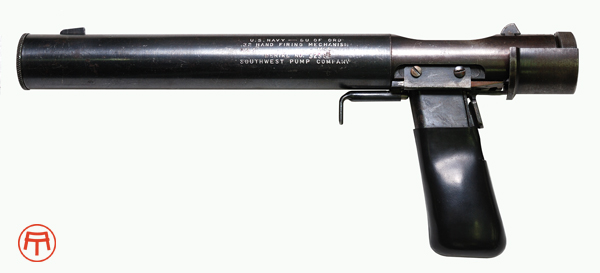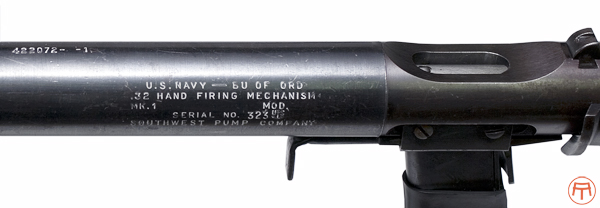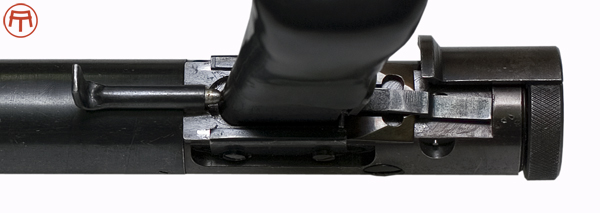|
The U.S. Welrod

The U.S. build Welrod. Note the modified bolt handle which besides facilitate operation of the weapon when wearing gloves also doubts as a safety.
(Photo - Anders Thygesen courtesy of the Royal Armouries).
A document proving that the U.S. also produced a number of Welrods has finally been found. There is however no information as to when and how many. I remain convinced though that the wast majority of Welrods used by the U.S. during WWII were manufactured and delivered by the British. This assumption is further supported by a written report from a meeting between some British liaison officers and American OSS agents at the Maryland Research Laboratory, August 16, 1943 concerning silenced weapons. The Welrod was highly praised by all the participants and the report concludes:
[quote] "It was felt that for that special type of mission, it was the best available design and the U.S. should proceed with purchase of production model Welrods rather than trying for a home-built version". [/quote]
Concluding a later test likewise held at the Maryland Research Laboratory in September the same year, Stanley Lovell of the OSS wrote:
[quote] "There seems little sense in wasting time or effort as the British obviously have a superior design here. Suggest we provide funds for additional experimentation on .22 silenced pistols and on the submachine gun models" [/quote]
In yet another note dated October 9, 1943, Dr. Harris M. Chadwell writes to Dr. Vannevar Bush:
[quote] "If my information is correct, the Welrods were developed by the British group similar to the OSS" [/quote]
Still the U.S. at some point began manufacturing their own. At the MOD Pattern Room in England they have a specimen with a full inscription on the silencer tube reading:
U.S. NAVY ----- BU. OF ORD.
.32 HAND FIRING MECHANISM
MK 1. MOD.
SERIAL NO.323 (U.S. anchor)
SOUTHWEST PUMP COMPANY.

The U.S. build Welrod with it's inscription and part markings/blue print drawing numbers.
(Photo - Anders Thygesen courtesy of the Royal Armouries).
Some assert that the star and square found on the British Welrods are American markings, but I believe this theory can be excluded on the basis of a correspondence I had with The Naval Historical Center which states:
[quote] The Navy purchased an unknown number of Welrods for use. It is my understanding that they were given US Navy markings, with a final acceptance marking that was either "USN" or a stamped anchor.... The US Naval Gun Factory and other manufactures have small proof markings for some items, but none use the star. Part markings for NGF - made items may include blueprint drawing numbers, such as "NGF - 12345". [/quote]
Right after the serial number is stamped the anchor of the U.S navy with a "U" on its left side and an "S" on its right. In addition is engraved #422072--1 on top of the silencer tube, #422074--2 on the muzzle and #422072--6 on the back of the breech. These engravings can very well be drawing numbers for the individual parts as described in the letter from The Naval Historical Center. As there are no stampings of the star nor of the square on this model, the engravings agree well with the statement from The Naval Historical Center. Even if at first glance it appears to be a British Welrod, there are discernable differences. The difference are clearly seen on the individual parts which bears indication of a different manufacturing process just as the gun itself differs markedly by having something best described as a sleeve welded onto the side of the bolt handle which serves as a safety but also facilitate operation of the weapon when wearing gloves.

The U.S. build Welrod. Note that the grip safety has been modyfied by extending the bar that blocks the trigger platform so it protrudes all the way underneath the sleeve thus preventing firing before the bolt has been fully closed. In this photo the bolt has been fully closed enabling the safety bar to move freely. I have only seen one U.S. Welrod so if this modification was a standard feature or a prototype I haven't been able to disclose.
(Photo - Anders Thygesen courtesy of the Royal Armouries).
However, recently a folder labeled: HAND FIRING MECHANISM, Mark 1, Cal. .32” (CLASSIFICATION “SECRET” BUT REDUCED TO “RESTRICTED” ON 3/7/50), has been discovered in the archives of the Royal Armouries, UK.
The documents inside revealed a thorough description including photos of the British Welrod Mk.IIA marked with the usual five-pointed star, square and serial number 6197. The enclosed text explained that the Welrod in question had been surrendered to a war veteran, a former Ordnance officer, whose unit was in the Philippines.
Among the documents was also found a letter from the Navy Department Bureau of Ordnance, answering a request from the HP White Company in Cleveland, Ohio, U.S.A. regarding the origin of the Welrod. The questions and answers read:
[quote]
Q: How many were made and when?
A: No one knows for certain.
Q: By whom were they made?
A: No one company made them. Components were farmed out and assembled by the Navy for security reasons.
Q: Were the barrels rifled by the broaching process?
A: Yes.
Q: Is the magazine the standard type for the .32 auto?
A: Yes.
Q: To whom were the guns issued or were they dropped to resistance groups?
A: To resistance groups.
Q: Would like to obtain any instructions or manuals that went with these guns.
A: None were issued. The device was too hush-hush.
Q: Was ammunition issued with these guns?
A: The gun was designed for German and Jap 7,65 pistol ammunition and will naturally take our own caliber .32 automatic.
We have been given permission to show you blueprints but can’t give you a copy. The day we got your letter we got the Navy to declassify the damn thing, so we could answer your letter. It was still listed as Top Secret. [/quote]
From the content it would be safe to conclude that the U.S . HAND FIRING MECHANISM, Mark I, was classified as Secret until March 1950 and here after declassified to Restricted. But apart from that we have conflicting or at least confusing assertions. We know for a fact that B.S.A was the main contractor for the British Welrod and we also know that manuals and instructions were in fact written as early as 1943. The Welrod pictured and described in the document is without doubt British produced and has nothing to do with the above pictured U.S. version. Due to the great secrecy surrounding the project it would be reasonable to assume that a mix up between the two models has occurred.
The Southwest Pump Company was founded in 1916 and located in Bonham Texas, a very small community northeast of Dallas near the border between Texas and Oklahoma. The company was later taken over by Tokheim Corporation and finally closed down in 1999.
Thanks to John Finnell new and valuable information regarding this production facility has emerged. Mr. Finnell wrote me and told that his late Grandfather worked at the Southwest Pump Company as a machinist for over 40 years, including the timeframe when they were producing Welrods. He was a master machinist who did many different jobs but his main responsibility was pulling rifling’s although he also did some assembly work.
His Grandfather also told him that it was not an uncommon occurrence for completed pistols to be “tested” at night upon the roof of the building by the workers, and he remember him describing how they made a very strange sound the first time they were fired but thereafter they were amazingly quiet.
It was also rumored that a number of people working there at the time have assembled their own Welrods from spare parts. Although it is only a rumor, it seems plausible, and there have properly only been a few if any measures in place to prevent it at that time.
As late as in the 1960’s a modified version of the Welrod Mk IIA was produced by Military Armament Corporation headed by Mitchell Wer-Bell. The main differences from the original design consisted of replacing the ebonite on the grip with plastic and replacing the original insides of the tube with the more up-to-date silencer technology of Sionics. It has not been disclosed how many were made but most likely it was no more than a handful.
|
